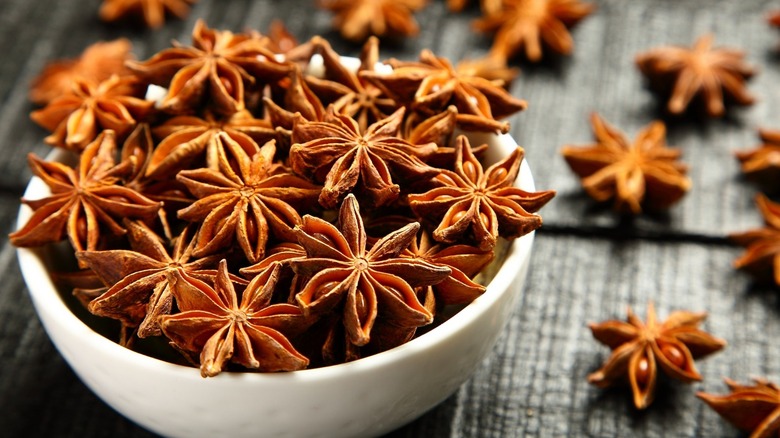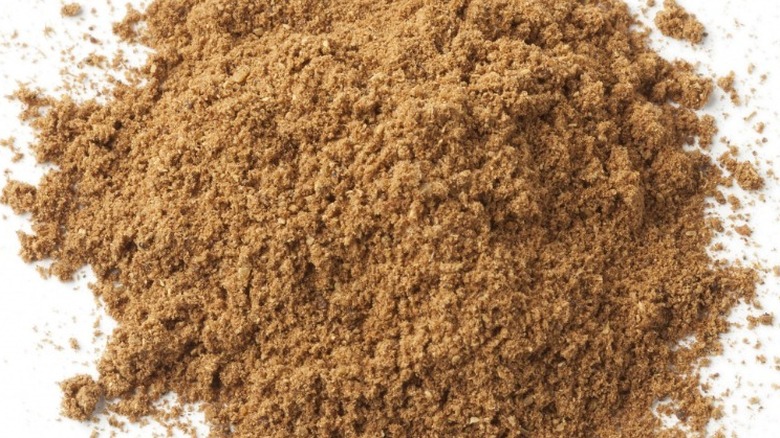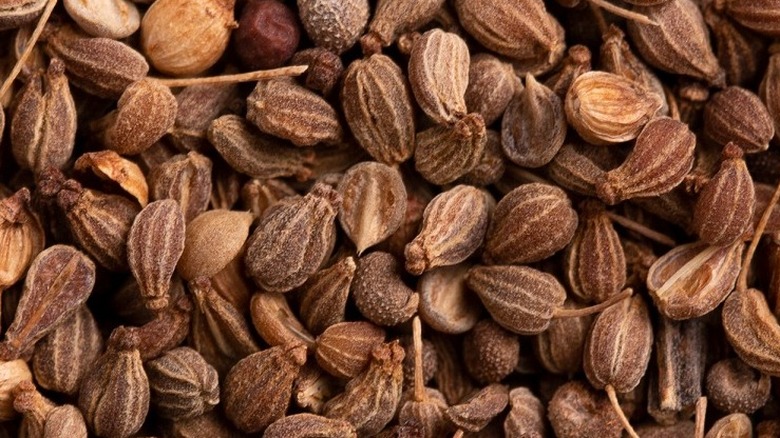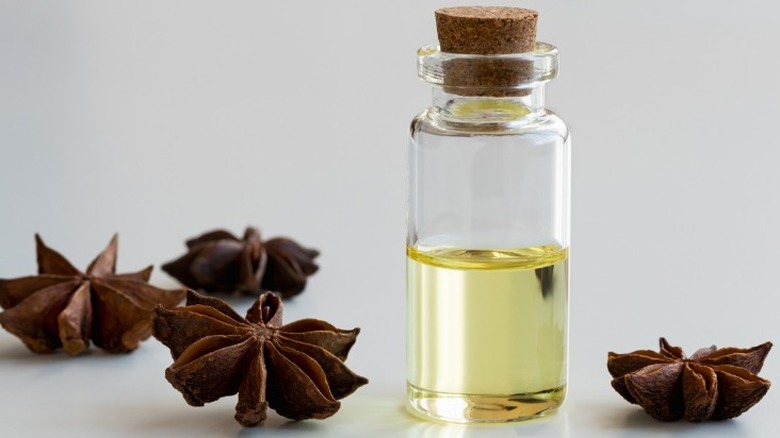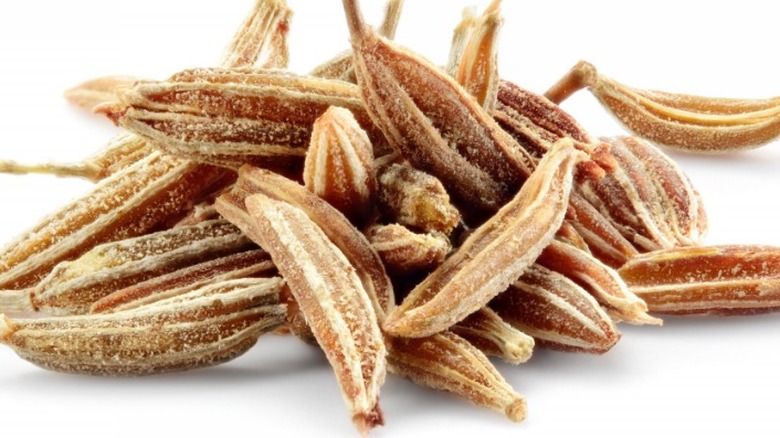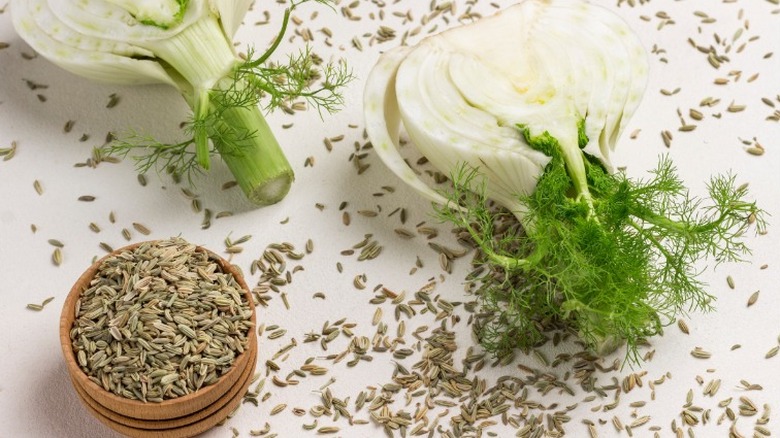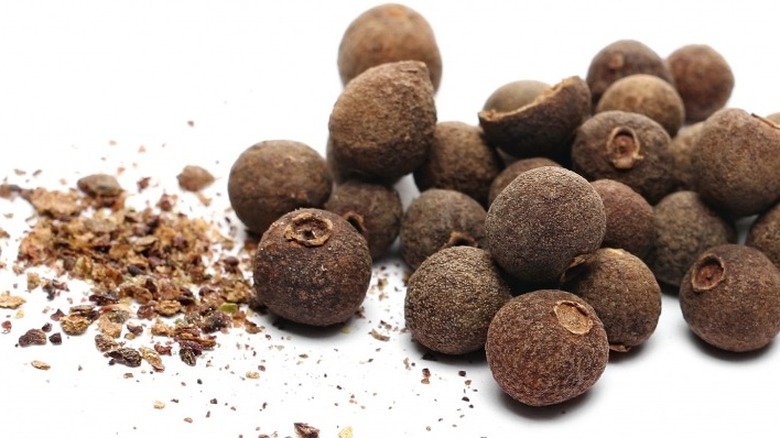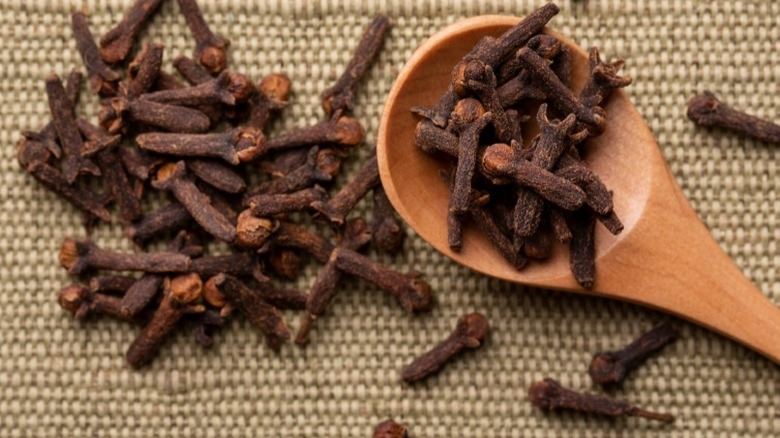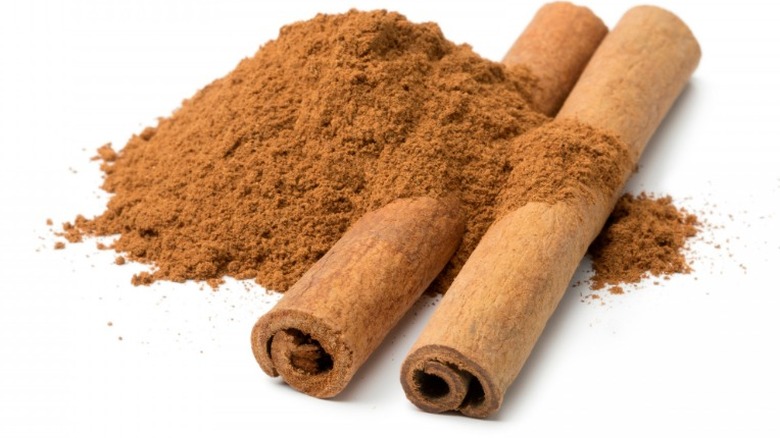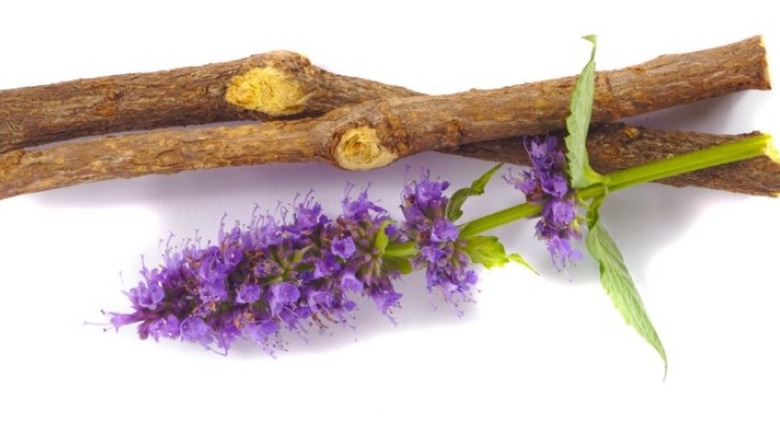10 Best Substitutes For Star Anise
You're taking a break from Zoom calls and decide to organize your spice rack to get some inspiration on what to cook for dinner. But as you push the basil and curry powder out of the way, lo and behold, you find something unexpected. It's the jar of ground star anise you bought many years ago after finding a spice-rubbed chicken thighs recipe that you had to try.
While we normally think of star anise as a spice, hence its spot on the spice rack, this licorice-flavored oddity is actually a fruit. Indigenous to China and Vietnam, star anise comes from the Chinese evergreen tree, or Illicium verum if you want to get all science-y about it. These trees take about six years to produce the green fruit, and up to a whopping 15 years to harvest and dry it into the brown starry pods we all love to admire (via Spices Inc).
According to Gardening Know How, the fruit is actually an 8-chambered pod called a schizocarp. Each chamber on the star point hugs a tiny, shiny seed. Though, it's not the seed that packs the fruit's unique licorice flavor, but the chamber itself. You might have seen these majestic stars steeping in holiday spiced punch or in jars of pickled cucumbers — and, when ground, star anise adds extra depth to meat marinades, apple pie, and fall bread recipes.
But, if your star anise is no longer the freshest, and you're still determined to make that chicken thighs recipe, it's good to know there are several great substitutes that come pretty close to this warm, sweet, and earthy flavor.
1. Chinese five-spice powder
Without a doubt, the best substitute for star anise is Chinese five-spice powder, the spice that gives dishes like Peking duck and chicken stir fry their balanced umami punch. Star anise is the flavor-forward ingredient of the five that make up this versatile powder and give it its name — along with a Chinese variety of cinnamon called cassia cinnamon, ground fennel seeds, Szechuan pepper, and cloves.
A Couple Cooks points out something to keep in mind when using the powder: "If your recipe calls for whole spices, like in mulled cider, you may not want to use a ground spice (or just strain it before drinking)." You might also try using Chinese five-spice powder first if you aren't familiar with star anise, just to make sure you like the flavor.
For this swap, use one-and-a-half teaspoons of five-spice powder for every 2 teaspoons of ground star anise that your recipe requires.
2. Anise seeds
One of the oldest cultivated plants, anise was enjoyed by the Romans, Greeks, and even our early American settlers. Greek philosopher Pythagoras thought it could prevent epilepsy, and the colony of Virginia in early America had all settlers plant it (via FoodReference.com).
And while you might think that star anise and anise seeds are related, they're actually from two very different plants, two different regions of the world, and two different growing climates. Anise seeds come from a herbaceous plant native to the Mediterranean and is more closely related to carrot or parsley, as opposed to star anise and its 65-foot evergreen tree in China, says Gardening Know How.
The spices do have a similar black licorice flavor, though anise seeds are much more delicate, sweet and spicy — for that reason, they work best in sweet dishes and after-meal liqueurs like Sambuca and Ouzo.
If you're going to substitute anise seeds for star anise, the ratio is about 3:4 to capture a similar flavor, but always go light-handed and then season to taste.
3. Anise extract
Since anise extract is a tincture made straight from the leaves and the seeds of the anise plant, using this concentrated form is going to give your dish a similar taste profile. And also like anise seeds, which are sweeter than star anise, this ingredient works best in cakes and cookies. It's a key ingredient in delicious treats like biscotti, pfefferneusse, peppernut cookies, and pizzelle.
Fun (or not so fun) fact: Anise extracts have been used as natural insecticides to combat commonly occurring food production pests, according to Self Hacked. Gardeners say the anise plant is a useful, nontoxic way for repelling harmful pests (and attracting beneficial insects). You can even make your own alcoholic extract if you're feeling extra productive one day and you have some extra anise seeds on hand, adds Self Hacked. Then throw a splash in your favorite cup of tea and relax.
When substituting anise extract for star anise, use a 1:1 ratio.
4. Caraway seeds
When coupled with some dried tarragon, caraway seeds can add a good amount of licorice kick to your dishes. Both seasonings have that licorice-y flavor thanks to the organic compound anethole. According to The Home of Cuisine, combining these two is a match made in heaven for your star anise swap. Since caraway seeds are well-known for their woody aromatics in savory foods like meatballs and rye bread, and tarragon is more of a sweet complex combo of vanilla, mint, and eucalyptus, the two together will come pretty close to the profile of star anise.
One thing to note is that caraway seeds can be pretty bitter and get even more bitter when cooking them, so A Pinch Of suggests adding them to sauce recipes in the last 15 minute of cook time.
To swap, use a half-teaspoon of caraway seeds and dried tarragon mixture in place of 1 teaspoon of ground star anise.
5. Fennel seeds
Fennel seeds come from fennel plants, which are green with a white bulb, feathery leaves, and yellow flowers. You can eat all parts of the plant, including the crunchy bulb, but the seeds pack the most licorice punch due to the oils they produce. In the Middle Ages, fennel was actually hung in doorways to guard homes from evil spirits, according to Just Fun Facts. The site says that the seeds were even stuffed into doorknob keyholes for extra protection.
Search for fennel seed recipes on the internet, and you get back over 3 million results, from fennel mashed potatoes to fennel-flavored ice cream (as seen on Epicurious). The flavor of fennel seed is lighter and more woodsy than star anise, which means that it works better as a background note that enhances the other spices in the sauces and savory meats you're cooking, says SPICEography.
When swapping, the star anise and fennel ratio is about 4:1, which means for every 1 teaspoon of star anise, use one quarter-teaspoon of fennel seeds.
6. Allspice
Unlike what its name might imply, allspice isn't a combo of every spice, but it is another swap to use in a pinch instead of star anise, especially for desserts. This powdered berry will appeal to folks who aren't fans of licorice since it doesn't have that same flavor profile. With clove, nutmeg, and cinnamon notes, this spice will give your dish a similar exotic and warm flair, but without the licorice overtones.
Speaking of warmth, according to The Great American Spice Co.,19th Century Russian soldiers added allspice to their boots to keep their feet warm. That might not fly today, but if do you try it, make sure you're wearing dark-colored socks!
If you add a little sugar to your ground allspice, it'll be perfect for sweet, warm drinks and Christmas-themed baked goods like gingerbread. Add some fresh ground pepper, and allspice does well in savory meat recipes like Jamaican jerk pork, vegetable soups, homemade sausages, and pates and terrines.
When substituting star anise with allspice, go with a 1:1 ratio.
7. Cloves
Cloves are another pungent spice (but really, an un-popped flower bud) that you can use in place of star anise, usually added to meat, savory sauces, desserts, wine, and chai. Their name comes from the French word "clou" which means "nail" (per MasterClass), since their shape is definitely nail-like. But cloves are in fact native to Indonesia, where they have been used for a variety of non-culinary items, one of the most popular being kretek, a cigarette blended with the spice and tobacco, says Sally's Organics. Ask someone alive in the '60s about clove cigarettes, and they'll know what you're talking about.
In whole form, like star anise, the bud steeps in a soup or sauce and is removed before serving. When it's ground, it's usually added to drinks or baked goods. Since the taste of cloves is like allspice, it's a good substitute for star anise (but you also won't get those licorice notes).
To substitute, use a 1:1 ratio of ground cloves to star anise in your recipe. If you're using whole cloves, The House of Cuisine suggests not cooking them too long as they release an oil that can add a bitterness to your dish.
8. Cassia bark powder
Whole and ground cassia bark looks almost like cinnamon and even comes from the same plant family, but has a slightly different flavor. The University of Iowa says cassia's taste is "more straightforwardly intense" than cinnamon, with warm and savory notes, making it a great sub for star anise.
Also called Chinese cinnamon (and one of the five ingredients in Chinese five-spice powder, as noted above), what most people don't know is that when you buy cinnamon from the grocery store, you're really getting cassia cinnamon. Some people consider another tree bark variety, ceylon cinnamon the "true" cinnamon. At the end of the day though, if you put both types of tree barks next to each other for a taste test you probably wouldn't be able to tell the difference between them.
You can use the suggested replacement in a 1:1 ratio of cassia bark powder to ground star anise, but you may want to use a little less or more depending on the final taste you're going for in the end.
9. Licorice root
Commonly used as a sweetener in making candies and baked goods, licorice root can be a good swap for star anise if you're one of the folks in the licorice-isn't-disgusting camp. On the rare occasion you do have licorice root in your spice rack (maybe it came with that gourmet spice gift set you got from cousin Eddie last Christmas), Hotline Recipes advises you can substitute it for star anise if the dish you're making is a sweet one.
One thing to note according to First Cry Parenting, licorice root powder does include a natural compound called glycyrrhizin which can cause health issues during pregnancy, so pregnant women should avoid it. But if you find yourself with a chest cold, feel free to whip up some licorice root tea,as Lady Lee's Home says it's a great herbal remedy that'll soothe a nasty cough.
You can go with a 1:1 ratio when using licorice root as a substitute in sweet recipes that call for ground star anise. But, use a little less for savory recipes.
10. Sambuca
Taking a shot of Sambuca is like a warm, sweet punch of star anise to the mouth. This super sweet Italian liquor is made from anise seeds, so like licorice root, it's going to add that distinct flavor to your dish. But what's with the coffee bean? Well it turns out that the bean enhances the licorice flavor native to the liqueur, and shots are supposed to be served with three coffee beans: One for health, one for happiness, and one for prosperity (via eHow). So if you're making a coffee-infused baked good, why not amp it up with some Sambuca?
One good thing about using Sambuca as a star anise substitute is that it's typically a clear liquid that won't compromise the color of your dish. But, because it is so sugary, you may want to stick to desserts when using it as a substitute. You can add it to savory dishes too, just be careful to taste test so you don't over-sweeten it. And don't forget to take a shot for yourself while cooking.
For best results, season to taste and use 1 tablespoon of Sambuca to replace a half-teaspoon of ground star anise.
